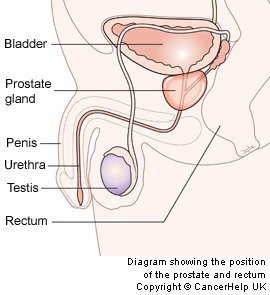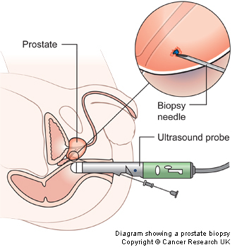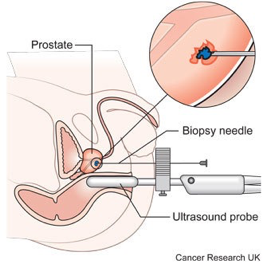This page tells you about diagnosing prostate cancer and the tests you might have. There is information about
- Seeing your GP
- PSA blood test
- Rectal examination
- Referral to hospital
- Tests that may be carried out
- After the tests
Seeing your GP
If you have symptoms that could be due to prostate cancer you should see your GP. They will examine you and ask about your general health. Your doctor will also take a blood test to check the levels of a protein called prostate specific antigen (PSA) in your blood. They will also do an examination of the prostate gland.
PSA blood test
Prostate-specific antigen, or PSA, is a protein produced by cells of the prostate gland. The PSA test measures the level of PSA in a man’s blood. For this test, a blood sample is sent to a laboratory for analysis. The results are usually reported as nanograms of PSA per milliliter (ng/mL) of blood.
PSA levels can be raised if a man has prostate cancer. But other medical conditions can also cause PSA levels to rise, such as an enlarged prostate that is not cancer called benign prostatic hyperplasia or BPH.
PSA can also be raised by prostate infection (prostatitis), exercise and sex. Some drugs used to treat a benign enlarged prostate can lower PSA ( Finastride/dutasteride)
Another problem is that all men have slightly different PSA levels. It is difficult to say what is normal, and what is high. This means that not all men with high PSA have prostate cancer. And not all men with prostate cancer have high PSA levels. But the following values are a rough guide, there is a range of normal PSA readings for every age group.
Age PSA Reference Ranges
40-49 0-2.5ng/ml
50-59 0-3.5ng/ml
60-69 0-4.5ng/ml
70-79 0-6.5ng/ml
Corresponding reference ranges for men of Africian ethnicity are 0-2.0ng/ml (40-49yrs) 0-4.0ng/ml (50-59) , 0-4.5ng/ml (60-69yrs) and 0-5.5ng/ml (70-79)
A reading higher than these values but less than 10 ng/ml is usually due to a non cancerous (benign)
Generally speaking, the higher the PSA level, the more likely it is that there is a cancer in the prostate. But in early prostate cancer, PSA levels are usually relatively low. It is not possible to pick out a particular PSA reading and say “people above this level have cancer and those below don’t”. The PSA level also naturally tends to get higher as men get older. As such, doctors cannot use the PSA test alone in diagnosing prostate cancer.
PSA blood tests are also used to monitor how well prostate cancer treatment works or to decide whether you need treatment. If your PSA is stable, it is a sign that a cancer is not growing or spreading. Successful treatment shrinks cancer and so the PSA level in the blood then falls.
If you are going to have a PSA blood test you should not have
- A urinary tract infection (UTI)
- Ejaculated for 48 hours beforehand
- Exercised heavily in the previous 48 hours
- Had a prostate biopsy within the last 6 weeks
 Rectal examination
Rectal examination
Your doctor puts a gloved finger into your back passage (rectum) to feel your prostate gland and check for abnormal signs, such as a lumpy, hard prostate. Doctors call this test a digital rectal examination (DRE).
Referral to hospital
If your GP finds anything that could be due to cancer they will refer you to hospital for more tests. The tests are used in diagnosing prostate cancer or to find out whether it has spread. You won’t need to have all of the tests. Your doctor will discuss the tests you’ll have and will explain what they are for.
At the hospital your doctor will usually repeat the PSA blood test and the rectal examination of the prostate.
Rectal ultrasound
You may have a rectal ultrasound scan to examine the prostate gland. It is called a trans rectal ultrasound (TRUS). You will need to make sure you have had a bowel movement beforehand so that your rectum is empty when you go for your appointment.
Your doctor puts a small ultrasound device about the width of a finger into your back passage. It produces sound waves to create a clear picture of the prostate gland. This test is uncomfortable, but shouldn’t hurt. It does not take long- likely less than 10 minutes.
Needle biopsy
If the doctor finds a lump or hardening of your prostate during your rectal examination or ultrasound, they may take a sample of cells (a biopsy) to examine under a microscope. The biopsy is most often done through your back passage (rectum) using the transrectal ultrasound scanner. It is then called a TRUS biopsy. The biopsy itself takes about 10 minutes and is usually done in the doctor’s office.
You can also have a biopsy taken through the skin behind your testicles (the perineum). Or you may have it while you are having a cystoscopy examination.
Having a needle biopsy
 You have the biopsy in the outpatient department. When you arrive at the hospital, a nurse will meet you. The nurse will ask you some questions and talk you through the procedure to ensure that you understand what will happen. You will have antibiotics to take to help stop infection developing after the biopsy.
You have the biopsy in the outpatient department. When you arrive at the hospital, a nurse will meet you. The nurse will ask you some questions and talk you through the procedure to ensure that you understand what will happen. You will have antibiotics to take to help stop infection developing after the biopsy.
Before you have the biopsy, the doctor, usually an expert doctor called a urolgogist, will show you the ultrasound machine and the very fine needle used to take the tissue samples. The needle is attached to a firing mechanism which makes a particular noise (Like the clicking of a pen). The doctor will show you this and demonstrate the noise so you know what to expect. The doctor will explain the whole procedure before they start and give you a chance to ask whatever questions you need to.
Using TRUS ultrasound to “see” the prostate gland, the doctor quickly inserts a thin, hollow needle through the wall of the rectum into the prostate. When the needle is pulled out it removes a small cylinder (core) of prostate tissue. This is repeated from 8 to18 times, but most urologists will take about 12 samples.
Though the procedure sounds painful, each biopsy usually causes only a brief uncomfortable sensation because it is done with a special spring-loaded biopsy instrument. The device inserts and removes the needle in a fraction of a second.
After the biopsy
After the test, you will wait at the hospital to have a rest and a drink. You can then go home. It is very important to drink a lot of fluids for the next 24 hours. Your prostate gland will bleed slightly. And there is a risk of urinary tract infection (UTI). Drinking plenty of fluid flushes out the blood and helps to stop any infection from developing. You will see a small amount of blood in your urine, back passage and semen after the test. This may carry on for a few weeks, but is nothing to worry about. But you should contact your doctor if you think you are getting an infection.
You should phone your doctor immediately or go to the A&E if you have
- Shivering or shaking
- A high temperature
- A lot of difficulty passing urine
- A need to pass urine very often
- A lot of blood in your urine or bowel movement
You will need antibiotics straight away if you have a urine infection.
MRI scan
If your prostate biopsy does not find cancer cells but you have a high PSA level, it may mean that the biopsy missed the cancer cells. Your doctor may suggest that you wait a few months and then have an MRI scan.
An MRI scan uses magnetism to build up a picture of the inside of the body. It can show up abnormal areas in the prostate gland.
Template biopsy or targeted biopsy
If a prostate biopsy is negative but your doctor thinks there you may have a small tumour on your prostate, they may suggest that you have a trans perineal template biopsy or targeted biopsy. These procedures can sometimes find a prostate cancer that has been missed by other types of biopsy.
Template biopsy
 You have a template biopsy under local or general anaesthetic and may have a tube (catheter) inserted into your bladder to drain urine. You have antibiotics beforehand.
You have a template biopsy under local or general anaesthetic and may have a tube (catheter) inserted into your bladder to drain urine. You have antibiotics beforehand.
To do the biopsy the doctor puts a template with holes approximately 5 mm apart over the area of skin behind the testicles (the perineum). With the guidance of an ultrasound, the doctor puts a biopsy needle in through the different holes in the template, to take samples from particular areas of the prostate. They may take between 30 to 50 samples.
Targeted biopsy
For a targeted biopsy your doctor uses information from your ultrasound scan and also the information from an MRI scan. This helps them to accurately take biopsies from abnormal areas of the prostate gland.
After a template biopsy or targeted biopsy
After the test, you have a rest and a drink. You can then go home. The possible problems after these tests are the same as after a needle biopsy, outlined above. You need to drink plenty of fluids and let your doctor know straight away if you have signs of infection.
After the tests
Waiting for test results or for further tests can be a very worrying time. You may have contact details for a specialist nurse and you can contact them for information if you need to. It may help to talk to a close friend or relative about how you feel.
Some men need further tests. You can find information about these tests here.
Donate to Marie Keating
We hope you found this information useful. The Marie Keating Foundation offers all of our services for free. Help support people at every step of a cancer journey by making a donation today.
DONATE
